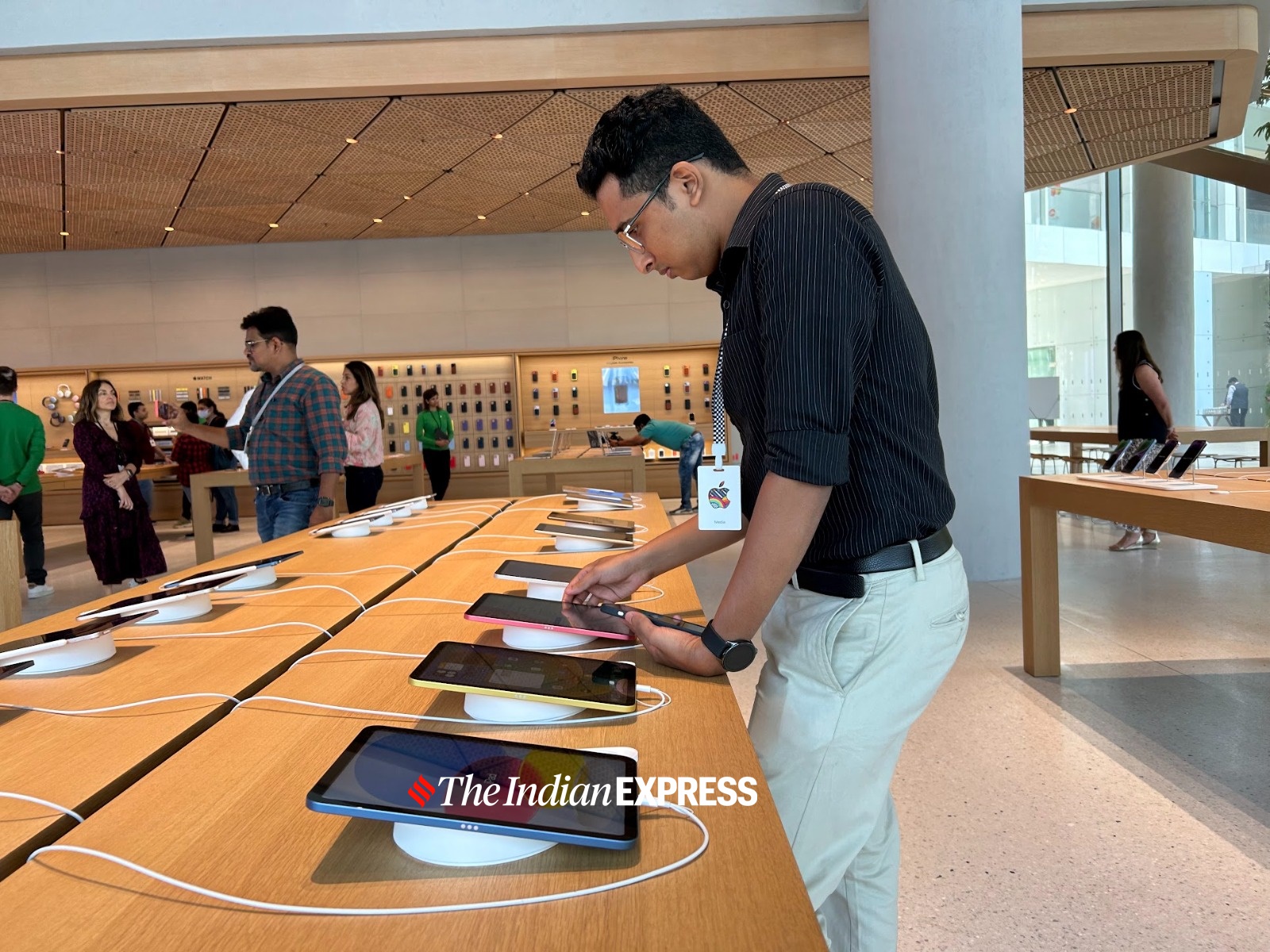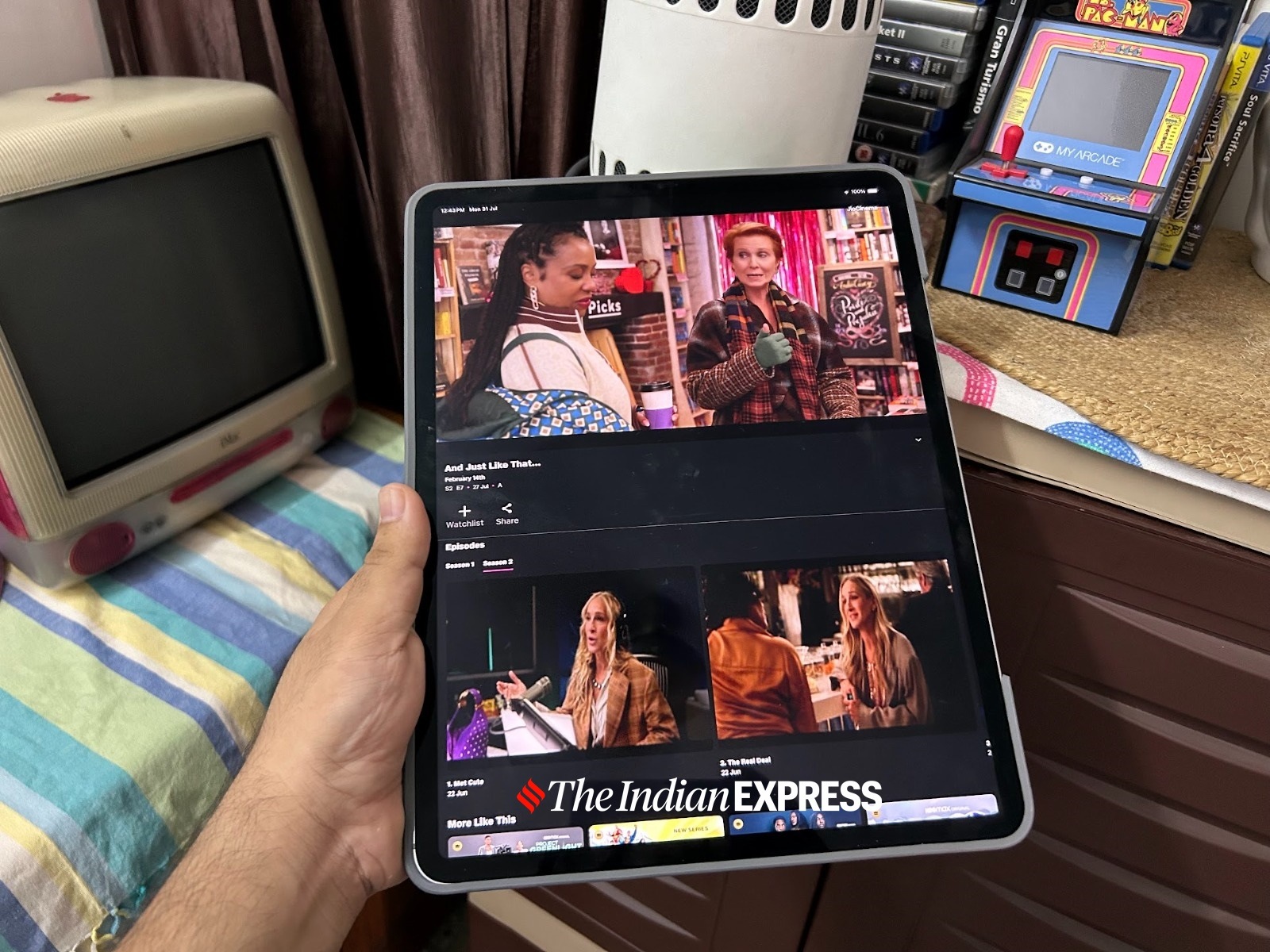
But more than the looming competition, the iPad, as a product category, hasn’t quite reached the level Apple CEO Tim Cook had envisioned. At the beginning, during the early days of the iPad, the tablet was meant to be a consumption-only device. Sales were on fire, and so was the iPad. However, the moment Apple tried to add more models, kept increasing the screen size and brought more processing capabilities, the iPad went from a consumption device to a work machine. In reality, however, the change in narrative didn’t go as planned, and instead of becoming a Mac-like machine, the iPad became, well, a confused device. Over the years, the iPad has been reduced to a minor component of Apple’s overall sales, and the change in strategy might need to be blamed.
 The iPad Pro got a bezel-less screen design, FaceID and USB-C connectivity in 2018. (Image credit: Anuj Bhatia/Indian Express)
The iPad Pro got a bezel-less screen design, FaceID and USB-C connectivity in 2018. (Image credit: Anuj Bhatia/Indian Express)
Mikako Kitagawa, Director Analyst at Gartner, agrees that the iPad does not come to the Mac or Windows PCs when it comes to productivity tasks. However, the iPad shines at creative tasks like drawing. Ben Wood, Chief Analyst & CMO at CCS Insight, chimes in, adding that while the iPad did a good job in bringing a PC-like touch-screen experience to those who wanted it, it’s an expensive device compared to some cheaper Windows-based PC alternatives. He cites the example of the high-end iPad Pro to prove the point. “The iPad Pro is a very capable device, and when paired with the Magic Keyboard, it can be used in a PC-like fashion, but it’s still not the complete experience,” he tells indianexpress.com.
Perhaps the biggest thing that backfired for the iPad is Apple’s decision to introduce different models at different prices to “cater to everyone”. There’s a high-end iPad Pro for productivity and designers, a mid-range iPad Air, the iPad mini, and the standard iPad. Some of them are subdivided based on screen size, while others are available in two different generations. To further complicate the buying process, Apple’s accessories like a keyboard case and Apple Pencil support certain models and not all. For example, the new Pencil (the one with USB-C) – the most budget option – doesn’t work with the cheapest iPad but works with the 10th generation iPad.
It’s so hard to choose the Apple Pencil (more than the iPad, in fact). The average consumer doesn’t know which iPad to choose or whether it is the right model for their needs. That’s the iPad situation right now. More troubling is Apple’s irregular timelines to update the iPad. In the case of the iPhone, Apple launches new iPhones every year in September, so consumers already know which model gets replaced and when. However, it’s hard to predict when Apple will introduce a new iPad – because you can’t predict. In fact, the iPad line hasn’t been updated in about 18 months.
Simplifying the iPad lineup (as well as the Apple Pencil) could be the first step to streamline the tablet range. Apple needs to focus on just two iPad lines, similar to what it did with the MacBooks (the high-end MacBook Pro and the low-end MacBook Air): the iPad Pro and the iPad Air. The two lines should be clearly distinguished, with the Pro models getting better and larger displays, faster processors, and more premium accessories – but at a higher price. The Air, on the other hand, needs to be lighter, more portable, and of course, come at a mid-range price point. That means Apple has to retire the remaining standard iPads – both 9th and 10th generation iPads, but can still continue selling the iPad mini, which becomes the entry model in the iPad family.
Story continues below this ad
The iPad needs some excitement, and it can only happen if Apple is willing to take risks and sell the iPad differently. After all, the biggest competition for the iPad comes from Apple’s own Mac – and not from other tablets. Whether Apple admits it or not, the premium iPad Pro already peaked in 2018 with the last big redesign. Apple can’t sell the new iPad on the promise of better displays and faster processors anymore, and the company knows it.
 The iPad wasn’t just a giant iPhone, as many had called it during its launch in 2010. (Image credit: Anuj Bhatia/Indian Express)
The iPad wasn’t just a giant iPhone, as many had called it during its launch in 2010. (Image credit: Anuj Bhatia/Indian Express)
However, despite the iPad Pro getting top-end silicon and bright and punchy OLED displays, many are skeptical that the high-end Pro models bring anything new, especially in their current form and iteration.
The problem is that the iPad Pro as a concept already feels mature to a point where it is hard to keep innovating at the same speed as it was once possible. Previously, the iPad Pro had an advantage over the Mac because it used an ARM chip, which was not only blazing fast but also had a long battery life. However, after Apple introduced the M1 chip, Mac chips were based on the same technology as the chips in iPhones and iPads. The chip advantage that the iPad had once was already gone with the introduction of the M-series chip on the Mac.
Although for years Apple tried to blur the line between the iPad and Mac, the more expensive iPad Pro still feels like an iPad. Some agree that Apple needs to better position the iPad Pro and find a new use case and possibly a new demography. Right now, the iPad Pro seems like a secondary device to someone who already uses a Mac, possibly a high-end MacBook Pro to get the work done. It’s very rare for a user to simply use an iPad Pro for drawing and sketching as a primary use case over other things.
Story continues below this ad
“I actually think it might be more about how Apple makes the Mac more iPad-like. The elephant in the room is Apple’s continued reluctance to offer a touch-screen Mac. It might be that this never changes, but that feels like the opportunity to me,” Wood responded when asked about what Apple can do to make the iPad more like a Mac.
But what Apple really needs to do to make the iPad Pro shine over other devices, especially pro-grade tablets from Samsung and Huawei, is what it does differently with the accessories. At Apple’s May 7 event next week, both the Apple Pencil and Magic Keyboard are expected to get an upgrade, with the stylus possibly offering haptic feedback for the first time. But that might not be enough to trickle upgrades.
“OLED is great to perform the precise colour, and Pencil 3 must provide a great user experience but it would not create the incremental growth for iPad Pro,” warns Kitagawa.
The missing piece of the puzzle is if Apple ever brings a layer of modularity to the iPad Pro, which could unlock endless possibilities for the iPad in the future. To date, Apple has never utilized the iPad Pro’s three-pin connector on the back that’s used for connectivity to accessories like the Magic Keyboard for other options. Third-party accessories makers have raised their concerns with the pogo-pin implementation, so it remains to be seen if Apple listens to them and creates an accessories ecosystem around the iPad Pro and passing it down to other iPads in the future.
Story continues below this ad
 The iPad is a fantastic option as a consumption device, but it’s increasingly being pitched as a work machine. (Image credit: Anuj Bhatia/Indian Express)
The iPad is a fantastic option as a consumption device, but it’s increasingly being pitched as a work machine. (Image credit: Anuj Bhatia/Indian Express)
However, industry watchers are more keen on what Apple does to iPadOS and how it supercharges it by adding a dash of AI. Apple has been slow to integrate AI into its core products and services, lagging behind Microsoft, Google, and other tech companies. But with Apple’s Worldwide Developers Conference a few days away, Cupertino may be gearing up for a big AI reveal, and it could start with the iPad.
“Incremental improvements to the display and Pencil will be a talking point, but I’m more interested to see what artificial intelligence-powered capabilities are revealed in iPadOS 17.5,” says Wood. “Although WWDC in June will be the main focus for generative AI news, we might see something unveiled for the iPad Pro – particularly if it includes an Apple Silicon M3 or M4 processor,” he adds.
Apple hasn’t unveiled its own AI models yet or competing AI features that Google and Samsung are rolling out on their devices, but CEO Tim Cook recently teased a major announcement coming this year. However, as industry insiders have said, it may not be enough for Apple to market the iPad Pro as its “first AI-powered device”; it also needs to show the AI software and features that are optimised for the tablet’s form factor, taking full advantage of the device’s Magic Keyboard and Apple Pencil. These things can make the iPad significantly different from the Mac, tablets, and PCs, thereby flipping the narrative that Apple once bet on but didn’t pursue too far.
This is the best time for Apple to reimagine the iPad and create a new identity and just admit once and for all that the iPad can never replace a Mac. Period.



 The iPad Pro got a bezel-less screen design, FaceID and USB-C connectivity in 2018. (Image credit: Anuj Bhatia/Indian Express)
The iPad Pro got a bezel-less screen design, FaceID and USB-C connectivity in 2018. (Image credit: Anuj Bhatia/Indian Express) The iPad wasn’t just a giant iPhone, as many had called it during its launch in 2010. (Image credit: Anuj Bhatia/
The iPad wasn’t just a giant iPhone, as many had called it during its launch in 2010. (Image credit: Anuj Bhatia/ The iPad is a fantastic option as a consumption device, but it’s increasingly being pitched as a work machine. (Image credit: Anuj Bhatia/Indian Express)
The iPad is a fantastic option as a consumption device, but it’s increasingly being pitched as a work machine. (Image credit: Anuj Bhatia/Indian Express)





